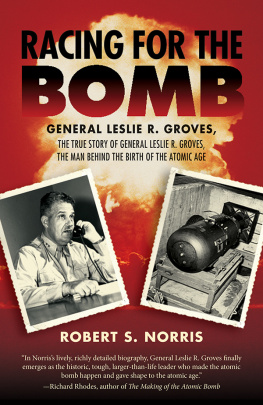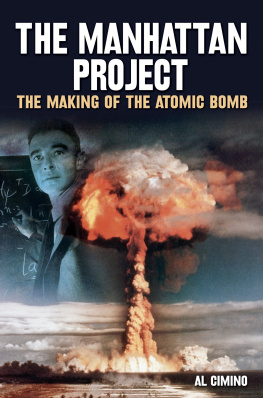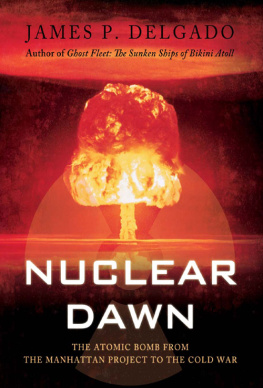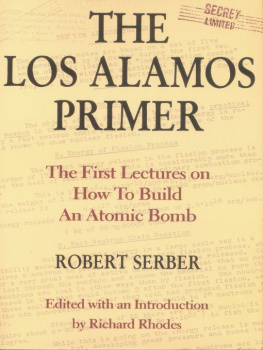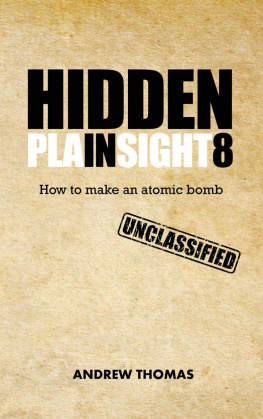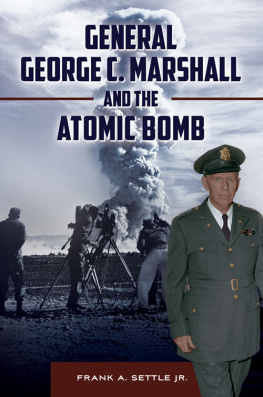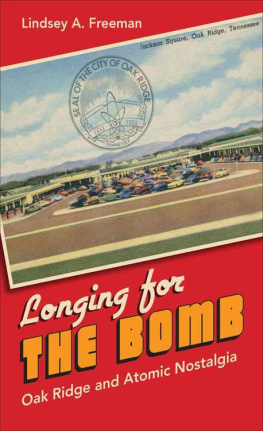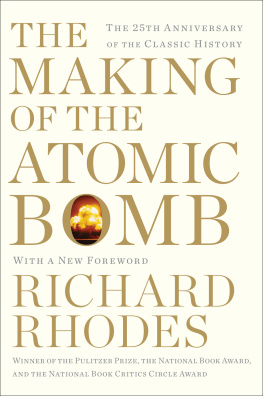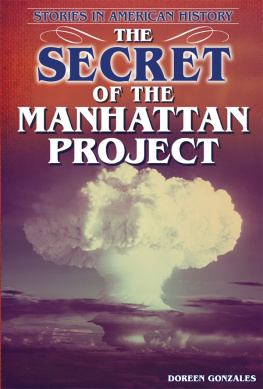Bruce Cameron Reed - The atomic bomb: the story of the Manhattan Project: how nuclear physics became a global geopolitical game-changer
Here you can read online Bruce Cameron Reed - The atomic bomb: the story of the Manhattan Project: how nuclear physics became a global geopolitical game-changer full text of the book (entire story) in english for free. Download pdf and epub, get meaning, cover and reviews about this ebook. year: 2018, genre: Romance novel. Description of the work, (preface) as well as reviews are available. Best literature library LitArk.com created for fans of good reading and offers a wide selection of genres:
Romance novel
Science fiction
Adventure
Detective
Science
History
Home and family
Prose
Art
Politics
Computer
Non-fiction
Religion
Business
Children
Humor
Choose a favorite category and find really read worthwhile books. Enjoy immersion in the world of imagination, feel the emotions of the characters or learn something new for yourself, make an fascinating discovery.
- Book:The atomic bomb: the story of the Manhattan Project: how nuclear physics became a global geopolitical game-changer
- Author:
- Genre:
- Year:2018
- Rating:4 / 5
- Favourites:Add to favourites
- Your mark:
- 80
- 1
- 2
- 3
- 4
- 5
The atomic bomb: the story of the Manhattan Project: how nuclear physics became a global geopolitical game-changer: summary, description and annotation
We offer to read an annotation, description, summary or preface (depends on what the author of the book "The atomic bomb: the story of the Manhattan Project: how nuclear physics became a global geopolitical game-changer" wrote himself). If you haven't found the necessary information about the book — write in the comments, we will try to find it.
The atomic bomb: the story of the Manhattan Project: how nuclear physics became a global geopolitical game-changer — read online for free the complete book (whole text) full work
Below is the text of the book, divided by pages. System saving the place of the last page read, allows you to conveniently read the book "The atomic bomb: the story of the Manhattan Project: how nuclear physics became a global geopolitical game-changer" online for free, without having to search again every time where you left off. Put a bookmark, and you can go to the page where you finished reading at any time.
Font size:
Interval:
Bookmark:
Atomic Bomb: The Story of the
Manhattan Project
How nuclear physics became a global geopolitical game-changer
Bruce Cameron Reed
Department of Physics, Alma College, Michigan, USA
Morgan & Claypool Publishers
Copyright 2015 Morgan & Claypool Publishers
All rights reserved. No part of this publication may be reproduced, stored in a retrieval system or transmitted in any form or by any means, electronic, mechanical, photocopying, recording or otherwise, without the prior permission of the publisher, or as expressly permitted by law or under terms agreed with the appropriate rights organization. Multiple copying is permitted in accordance with the terms of licences issued by the Copyright Licensing Agency, the Copyright Clearance Centre and other reproduction rights organisations.
Rights & Permissions
To obtain permission to re-use copyrighted material from Morgan & Claypool Publishers, please contact .
ISBN 978-1-6270-5991-6 (ebook)
ISBN 978-1-6270-5990-9 (print)
ISBN 978-1-6270-5993-0 (mobi)
DOI 10.1088/978-1-6270-5991-6
Version: 20150601
IOP Concise Physics
ISSN 2053-2571 (online)
ISSN 2054-7307 (print)
A Morgan & Claypool publication as part of IOP Concise Physics
Published by Morgan & Claypool Publishers, 40 Oak Drive, San Rafael, CA, 94903, USA
IOP Publishing, Temple Circus, Temple Way, Bristol BS1 6HG, UK
This work is dedicated to Laurie.
Again.
The dropping of atomic bombs on the Japanese cities of Hiroshima and Nagasaki to help end World War II was one of the most controversial events of the twentieth century, not to mention a stunning example of how scientific and technological developments can affect human affairs. Decades later, nuclear weapons continue to inspire fear, awe, and, especially for students of science, engineering, and history, almost unlimited curiosity. On what physical principles are these weapons based, and how do they function? How were the underlying principles discovered? Why can only certain forms of the uncommon elements uranium and plutonium be used to make nuclear weapons? What challenges were encountered in isolating these materials and in turning desktop-scale laboratory discoveries into real-world military weapons? Why did the United States Army project to develop these weapons come to be called the Manhattan Project? How was the work organized and kept secret, and who were the leading personalities involved? How were the target cities chosen? Were other options considered before direct use of the bombs was authorized? What effects did the bombs have?
My goal in writing this book was to prepare a self-contained, concise account of all of the major aspects of the Manhattan Project at a level accessible to readers who are familiar with basic concepts from high-school or college physics and chemistry classes such as protons, neutrons, isotopes, radioactivity, and units of energy. I begin in chapter examines the underlying science in some detail; in effect, this chapter is a mini-text on radioactivity, isotopes, and nuclear fission. Subsequent chapters describe how the Project was organized and carried out, how the worlds first nuclear weapon was detonated in the dramatic Trinity test in the desert of New Mexico, and the bombings of Hiroshima and Nagasaki. The last chapter offers a brief survey of postwar developments and current worldwide nuclear weapons deployments. Finally, the bibliography lists a number of published and electronic sources where more detailed information can be found.
I hope that this book whets your appetite to explore the Manhattan Project in more depth. But be warned: as anybody who seriously comes to this subject will attest, it can become addictive!
Cameron Reed
Midland, Michigan
May, 2015
At the time of the Manhattan Project, customary United States units such as pounds, feet and miles were still in widespread use in American scientific and engineering circles. Most original Manhattan documentation uses such units and I follow this pattern. SI equivalents are given for some of the more important quantities.
I have benefited from conversations, correspondence, suggestions, comments on draft material and general encouragement from John Abelson, Joseph-James Ahern, Dana Aspinall, Jeremy Bernstein, Alan Carr, David Cassidy, John Coster-Mullen, Steve Croft, Gene Deci, Eric Erpelding, Patricia Ezzell, Edward Gerjuoy, Chris Gould, Robert Hayward, Dave Hafemeister, William Lanouette, Irving Lerch, Jeffrey Marque, Albert Menard, Tony Murphy, Robert S Norris, Klaus Rohe, Frank Settle, Ruth Sime, D Ray Smith, Roger Stuewer, Michael Traynor, Alex Wellerstein, John Yates and Pete Zimmerman. Al Bartlett, Harry Lustig and Bill Wilcox are unfortunately no longer with us, but deserve special mention for many fondly remembered conversations. Jeanine Burke and Joel Claypool of Morgan and Claypool Publishers deserve a big nod of thanks for believing in this project.
In addition to the individuals listed above, the influences of family members, teachers, classmates, professors, mentors, colleagues, students, collaborators and friends lie beneath these pages. Most of all I thank Laurie, who once again bore with it.
Bruce Cameron Reed
Bruce Cameron Reed is the Charles A Dana Professor of Physics at Alma College, Alma, Michigan. He holds a PhD in Physics from the University of Waterloo in Canada. In addition to a quantum mechanics text and two other books on the Manhattan Project, he has published over 100 papers in peer-reviewed scientific journals describing research in the fields of astronomy, data analysis, quantum physics, nuclear physics, the history of physics, and the physics of nuclear weapons. In 2009 he was elected a Fellow of the American Physical Society For his contributions to the history of both the physics and the development of nuclear weapons in the Manhattan Project. He lives in Michigan with his wife Laurie (an astronomer) and a constantly-varying number of cats.
IOP Concise Physics
Atomic Bomb: The Story of the Manhattan Project
How nuclear physics became a global geopolitical game-changer
Bruce Cameron Reed
This chapter offers a brief tour of why and for whom this book was written, a survey of some essential background scientific concepts and an overview of how this book is organized.
In August 1945, two United States Army Air Force B-29 bombers each dropped single atomic bombs on the Japanese cities of Hiroshima and Nagasaki. These devices, known colloquially as Little Boy and Fat Man, each exploded with energies equivalent to over ten thousand tons of conventional explosive, the normal payload of 1000 such bombers deployed simultaneously. Hiroshima and Nagasaki were destroyed and within days Japan surrendered, bringing an end to World War II. A 1946 analysis by the United States Strategic Bombing Survey estimated the total number of people killed in the bombings to be about 125 000, with a further 130 000160 000 injured.
These bombings represented the culmination of the work of the United States Armys Manhattan Engineer District, which in mid-1942 had been assigned responsibility for developing the bombs. After the war this effort became popularly known as The Manhattan Project. At the time, Manhattan was the most complex and costly research and development project ever undertaken. It has been estimated that nearly a half-million people were employed in the Projects factories and laboratories, with a peak steady-state employment of about 150 000. By August 1945, the cost of the Project had reached $1.9 billion, but secrecy surrounding the work was so intense that perhaps only a few dozen individuals held synoptic knowledge of the overall enterprise. As vast and successful as it was, however, the Project was by no means a sure thing: the entire undertaking was predicated on turning a recently discovered and incompletely understood physical phenomenon into a weapon that could be configured for operation in combat conditions. Manhattan represented an immense gamble of manpower, industrial capacity, and scientific and engineering ingenuity at a time when virtually every enterprise in the United States was turned to war production. Had history evolved slightly differently, Manhattan might equally well have made no contribution to ending the war. But it did succeed and its legacy includes Americas postwar military and political power, the Cold War, the thousands of nuclear weapons still held in the arsenals of various countries today, the threat of nuclear terrorism, and public apprehension with radiation and nuclear energy. No other twentieth-century scientific/technological development has had such a profound impact on human affairs.
Next pageFont size:
Interval:
Bookmark:
Similar books «The atomic bomb: the story of the Manhattan Project: how nuclear physics became a global geopolitical game-changer»
Look at similar books to The atomic bomb: the story of the Manhattan Project: how nuclear physics became a global geopolitical game-changer. We have selected literature similar in name and meaning in the hope of providing readers with more options to find new, interesting, not yet read works.
Discussion, reviews of the book The atomic bomb: the story of the Manhattan Project: how nuclear physics became a global geopolitical game-changer and just readers' own opinions. Leave your comments, write what you think about the work, its meaning or the main characters. Specify what exactly you liked and what you didn't like, and why you think so.




